The A. V. Lane Collection
at Bridwell Library
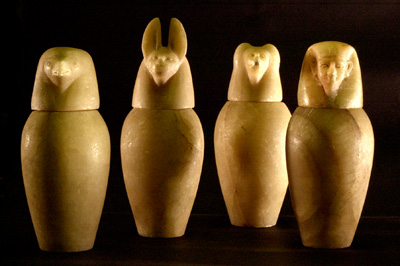
These canopic jars were purchased in 1941. The set of four jars feature lids carved to represent the four sons of Horus: the baboon “Hapy,” representative of the North and protector of the lungs; the god “Duamutef” jackel-headed guardian of the East, who protected the stomach; the hawk “Qebhsennuf” of the West, protector of the intestines; and the god “Imsety” of the South, human-headed guardian of the liver. These vital organs, removed during the mummification process, were preserved in canopic jars such as these.
On loan to the Dallas Museum of Art
Writing developed in Egypt and Mesopotamia more or less
simultaneously and independently between 3500 and 3000 BCE. The wedge-shaped
writing known as cuneiform (from the Latin cuneus – wedge) was used in
writing by the ancient Sumerians, Akkadians, Assyrians, Babylonians,
Persians and others.
Cuneiform cones or “nails” were buried in Sumerian building
foundations as part of ritual dedications. The limestone cone, found
at Tello, bears what was believed at the time of its discovery to be the
first known peace treaty (c. 3000 BCE), made between Entemena, King of
Lagash, and Lugalkinishududu, King of Erech (Uruk).
The two dedicatory clay cylinders were placed at the
entrances of buildings. (From the reign of Nebuchadnezzar II, 604–562
BCE). The smaller cylinder bears a generic inscription to the sun god
Shamash. The surface of larger cylinder is covered with a text
written in three columns of 145 lines, describing the building of the walls
of Babylon and temples, the Tower of “Babel” at
Ur, and several other biblical sites. A. V. Lane purchased it in 1932.

Bowl inscribed with an Aramaic incantation. Terra cotta.
Babylon, c. 500 BCE.
This rare specimen of Aramaic writing was purchased by A. V. Lane in 1931.
According to a tradition
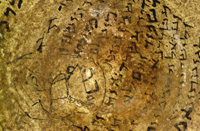 recounted
in early museum documents, by drinking water from this bowl, a Jewish exile
in Babylon could absorb the healing power of the incantation written within,
thereby casting out the evil spirit whose image has been drawn above the
bowl’s center. Shipped to the University of Chicago for study soon after its
purchase, the bowl inadvertently was stored away and forgotten, to be
rediscovered and returned to Bridwell Library only in 1981.
recounted
in early museum documents, by drinking water from this bowl, a Jewish exile
in Babylon could absorb the healing power of the incantation written within,
thereby casting out the evil spirit whose image has been drawn above the
bowl’s center. Shipped to the University of Chicago for study soon after its
purchase, the bowl inadvertently was stored away and forgotten, to be
rediscovered and returned to Bridwell Library only in 1981.
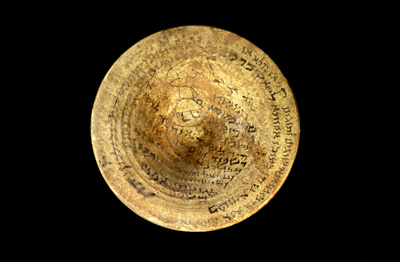
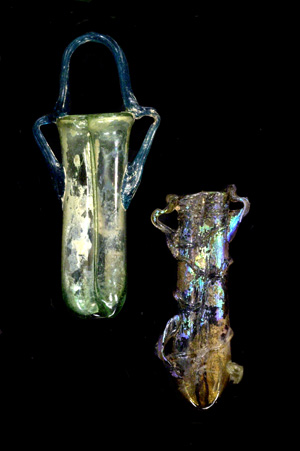
These double-chambered glass vials were used to mix pigment and oil for the application of cosmetics. A prior conjecture, disputed by research and comparison with similar ancient artifacts, suggested that these items were examples of lachrymatories, or “tear jars” for the collection of tears in rituals of mourning. The cosmetics vials were purchased by Dr. Lane in 1928 from the collection of Sir John Stirling Maxwell through the London-based antiquities dealers Spink & Son, Ltd.
A. V. Lane secured the permanent deposit of
twelve ancient papyrus fragments from the British Museum through his
connections with the Egypt Exploration Society of London in 1922. These
papyri, all from Oxyrhynchus, Egypt, are still among the most important
early texts in any collection in Texas.
Oxyrhynchus (modern el-Bahnasa), an ancient provincial capital along the
Bahr Yussuf, a minor branch of the Nile River in Lower Egypt, derived
its ancient name from a type of Nile sturgeon that was venerated
locally. The site of ancient archives and monastic libraries,
Oxyrhynchus flourished principally during the Roman era, although
earlier and later remains have been found there. The fame of Oxyrhynchus
today rests upon the discovery by the eminent British Bernard P.
Grenfell (1869–1926) and Arthur S. Hunt (1871–1934) of its deep rubbish
mounds containing thousands of ancient papyrus fragments. Excavated
between 1897 and 1907 (and now published in 65 scholarly volumes), the
papyri preserve Greek literary texts, private letters, legal documents,
and a few scraps of Christian scriptures, among which is the Bridwell
Library fragment recording Paul’s Epistle to the Romans, copied about
the year 600 CE.
P. Oxy. 1354 [Romans
1:1–16]. Greek. Ink on papyrus, Oxyrhynchus, Egypt, Sixth or
seventh century ce.
From the Egypt Exploration Society of London, British Museum, 1922.
This fragmentary papyrus leaf of the beginning of the Epistle of Paul the Apostle to the Romans, when complete, would have been approximately 11 < 7 inches. The upright script, in reddish-brown ink common to the period, is in the “Byzantine” style. In general, the left third of each line is missing. Shown is the recto, beginning with the text of Romans 1:1, where the first legible characters comprise the abbreviated name Iu Cu (“Jesus Christ”). The text on the verso breaks off midway through Romans 1:16.
Link to Bridwell Papyri


Mummified human remains. Painted cypress wood cartonnage.
The mummy came to the United States in 1897 as the property of Judge
Alexander Watkins Terrell (1827-1912), the Texas Senator for whom Terrell
County, Texas, was named. Terrell became U.S. Minister Plenipotentiary to
the Ottoman Empire under President Grover Cleveland and served as a diplomat
in a dispute between Egypt and the U.S (1893-97). In gratitude for this
service, the Egyptian government permitted Terrell to return to Austin with
a recently excavated mummy.
c. 1200 BCE.
From 1915 until 1926 SMU displayed the mummy in
Dallas Hall. In 1926 it became a part of the A. V. Lane Museum,
and with the rest of the contents of the museum, passed to Bridwell Library
in 1950.0.
On loan to the Dallas Museum of Art
Red quartzite fragment with Egyptian hieroglyphic writing, Egypt, c. 1350 BCE. Donated by A.V. Lane, 1927.
Although the date assigned to this fine hieroglyphic inscription in the 1920s was "about 3500 BC," recent research by SMU undergraduate Shelby Justl for Dr. Melissa Dowling has shown that the artifact is a cartouche bearing the name of the sun-deity Aten, from the reign of the pharaoh Akhenaten. Ms. Justl has demonstrated that the inscription is also known from several other cartouches made for Akhenaten. Her translation reads: "In his name comes wealth from Aten."
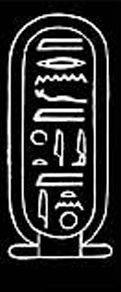
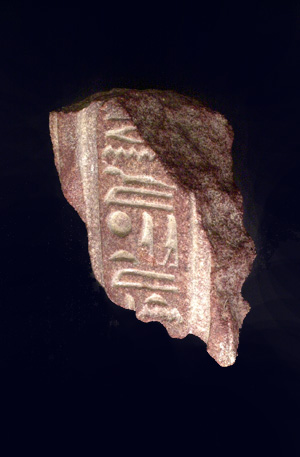
| BRIDWELL LIBRARY |
 |